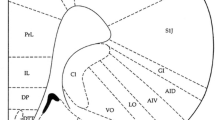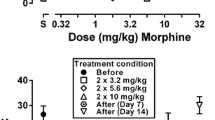Abstract
Previous animal studies have shown the antinociceptive effects of intrathecal clonidine and intrathecal morphine to be synergistic. This study investigated the intrathecal administration of multiple doses of this drug combination to examine the rate of development of tolerance and to determine whether there was any toxic effect on the spinal cord.
Rats with indwelling intrathecal catheters were given saline, morphine (2.5–7.5 μg), clonidine (17.5 μg), or clonidine (17.5 μg) plus morphine (1 μg) intrathecally twice daily for 41/2 days (total of 9 doses). Hot plate and tail flick tests were conducted after the first, fifth and ninth doses. After the ninth dose animals were killed and their spinal cords were removed for histological examination.
Tolerance developed to the antinociceptive effects of the drug combination, but at a slower rate than to morphine alone. No evidence of toxicity or injury to the spinal cord was observed other than changes which could be ascribed to the presence of the catheter.
Similar content being viewed by others
References
Bancroft JD, Stevens A (1982) Theory and practice of histological techniques. Churchill Livingstone, Edinburgh, pp. 306
Coombs DW, Fratkin JD, Meier FA, Nierenberg DW, Saunders RL (1985) Neuropathologic lesions and CSF morphine concentrations during chronic continuous intraspinal morphine infusion. A clinical and post-mortem study. Pain 22:337–351
Coombs DW, Saunders RL, Fratkin JD, Jensen LE Murphy CA (1986) Continuous intrathecal hydromorphone and clonidine for intractable cancer pain. J Neurosurg 64:890–894
Coombs DW, Jensen LB, Murphy C (1987) Microdose intrathecal clonidine and morphine for postoperative analgesia. Anesthesiology 67: A238
Cousi ns MJ, Cherry DA, Gourlay GK (1988) Acute and chronic pain: use of spinal opioids. In: Cousins MJ, Bridenbaugh P (eds) Clinical anesthesia and management of pain, 2nd edn. Lippincott, Philadelphia, pp 955–1029
DeConno F, Caraceni A, Martino C, Spoldi E, Salvetti M, Ventafridda F (1991) Hyperalgesia and myoclonus with intrathecal infusion of high-dose morphine. Pain 47: 337–339.
Eisenach JC, Dewan DM, Rose JC, Angelo JM (1987) Epidural clonidine produces antinociception, but not hypotension, in sheep. Anesthesiology 66: 496–501
Gordh TE, Ekman S, Lagerstedt A-S (1984) Evaluation of possible spinal neurotoxicity of clonidine, Upsala J Med Sci 89:266–273
Gordh T, Post C, Olsson Y (1986) Evaluation of the toxicity of subarachnoid clonidine, guanfacine, and a substance P antagonist on rat spinal cord and nerve roots. Anaesth Analg 65:1303–1311
Hogan Q, Haddox JD, Abram S, Weissman D, Taylor ML, Janjan N (1991) Epidural opiates and local anaesthetics for the management of cancer pain. Pain 46:271–279.
Kitahata LM (1989) Spinal analgesia with morphine and clonidine. Anesth Analg 68:191–193
Lehmann EL (1975) Nonparametrics. Statistical methods based on ranks. McGraw-Hill, New York, pp. 134–137
Loomis CW, Milne B, Cervenko FW (1988) A study of the interaction between clonidine and morphine on analgesia and blood pressure during continuous intrathecal infusion in the rat. Neuropharmacology 27:191–199
McLean CF, Mather LE, Odontiadis J, Sloan PA (1990) Improved method for morphine determination in biological fluids and tissues: rapid, sensitive and selective. J Pharm Pharmacol 42:669–671
Motsch J, Gräber E, Ludwig K (1990) Addition of clonidine enhances postoperative analgesia from epidural morphine: A double blind study. Anesthesiology 73: 1067–1073
Ossipov MH, Suarez LJ, Spaulding TC (1989) Antinociceptive interactions between alpha-2 adrenergic and opiate agonists at the spinal level in rodents. Anesth Analg 68: 194–200
Plummer JL, Cmielewski PL, Reynolds GD, Gourlay GK, Cherry DA (1990) Influence of polarity on dose-response relationships of intrathecal opioids in rats. Pain 40:339–347
Plummer JL, Cmielewski PL, Gourlay GK, Owen H, Cousins MJ (1991) Assessment of antinociceptive drug effects in the presence of impaired motor performance, J Pharmacol Methods 26:79–87
Plummer JL, Cmielewski PL, Gourlay GK, Owen H, Cousins MJ (1992) Antinociceptive and motor effects of intrathecal morphine combined with intrathecal clonidine, noradrenaline, carbachol or midazolam in rats. Pain 49:145–152
Sjöberg M, Karlsson P-A, Norborg D, Wallgren A, Nitescu P, Appelgren L, Linder L-E, Curelaru I (1992) Neuropathologic findings after long-term intrathecal infusion of morphine and bupivacaine for pain treatment in cancer patients. Anesthesiology 76:173–186
Solomon RE, Gebhart GF (1988) Intrathecal morphine and clonidine: antinociceptive tolerance and cross-tolerance and effects on blood pressure. J Pharmacol Exp Ther 245:444–454
Takano Y, Yaksh TL (1993) Chronic spinal infusion of dexmedetomidine, ST-91 and clonidine: spinal alpha2 adrenoceptor subtypes and intrinsic activity. J Pbarmacol Exp Ther 264:327–335.
VanEssen EJ, Bovill JG, Ploeger E (1991) Extradural clonidine does not potentiate analgesia produced by extradural morphine after meniscectomy. Br J Anaesth 66:237–241
Ventafridda V, Tamburini M, Caraceni A, DeConno F, Naldi F (1987) A validation study of the WHO method for cancer pain relief. Cancer 59:850–856
Wilcox GL, Carlsson K-H, Jochim A, Jurna I (1987) Mutual potentiation of antinociceptive effects of morphine and clonidine on motor and sensory responses in rat spinal cord. Brain Res 405:84–93
Wilczynska-Wojtulewicz I, Sadlij-Sosnowska N (1986) Determination of clonidine hydrochloride in pharmaceutical preparations by high-performance liquid chromatography. J Chromatogr 367:434–437
Yaksh TL, Collins JG (1989) Studies in animals should precede human use of spinally administered drugs. Anesthesiology 70:4–6
Yaksh TL Reddy SVR (1981) Studies in the primate on the analgesic effects associated with intrathecal actions of opiates, α-adrenergic agonists and baclofen. Anesthesiology 54:451–467
Yaksh TL, Noueihed RY, Durant PCA (1986) Studies of the pharmacology and pathology of intrathecally administered 4-anilinopiperidine analogues and morphine in the rat and cat. Anesthesiology 64:54–66
Author information
Authors and Affiliations
Rights and permissions
About this article
Cite this article
Plummer, J.L., Cmielewski, P.L., Tallents, S. et al. Development of tolerance to antinociceptive effects of an intrathecal morphine/clonidine combination in rats. Naunyn-Schmiedeberg's Arch Pharmacol 351, 618–623 (1995). https://doi.org/10.1007/BF00170161
Received:
Accepted:
Issue Date:
DOI: https://doi.org/10.1007/BF00170161




